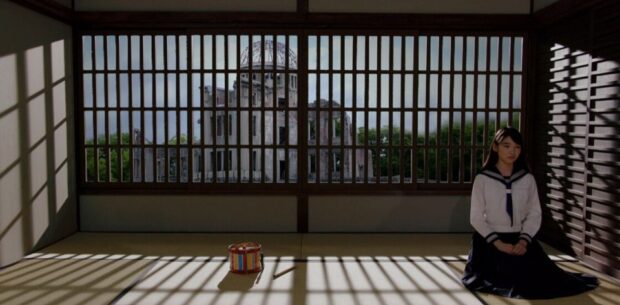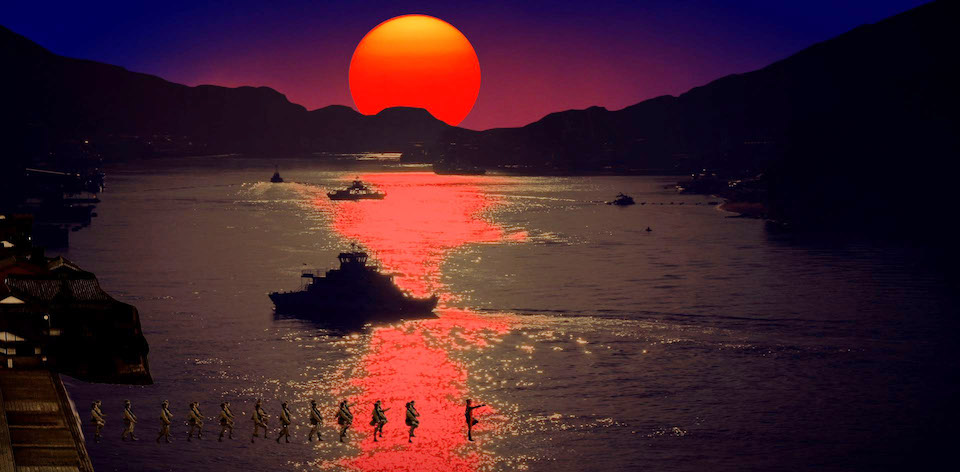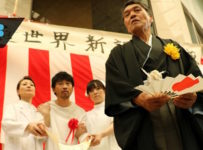It’s amazing that this movie exists at all. Nobuhiko Obayashi’s final film began production during the making of Hanagatami. Written, shot and chopped while he was dying of Stage 4 cancer, it’s his final love letter to the medium he adored.
So, in the sprawling three-hour LABYRINTH OF CINEMA (海辺の映画館 キネマの玉手箱), Obayashi delivers something closer to a visual essay than a traditional narrative. The loose plotting, cut together with the work of pre-War poet Chūya Nakahara, sees three young men (Takuro Atsuki, Takahito Hosoyamada, and Yoshihiko Hosoda) visit the last cinema in the Hiroshima prefecture port town of Onomichi during its closing night celebrations.
Amidst the performances onscreen and on stage, the audience is surprised to see local schoolgirl Noriko (Rai Yoshida) appear on the screen. The young men follow her into the film and soon find themselves on a voyage through Japan’s cinematic and military history. Surrounded by death and violence, their journey builds to a fateful day in Hiroshima on 6 August 1945.

Given the circumstances surrounding the creation of this film, it’s unsurprising that there’s an intensely autobiographical thread running through LABYRINTH OF CINEMA. Following the seminal House (1977), Obayashi made several films set in his hometown of Onomichi: I Are You, You Am Me (1982), The Girl Who Leapt Through Time (1983) and Lonely Heart (1985). His last film isn’t simply a nod to that early work but the closure of a circle.
While a degree in Japanese culture and history isn’t necessary for the full enjoyment of this venture, Obayashi certainly takes us through some touchstones that may not be as familiar to western audiences as they are to Japanese filmgoers. In addition to Japanese wars, there are far too many cinematic references to name here. That said, Muhomatsu no issho (variously known in English as Matsu the Untamed and The Rickshaw Man) serves as one of several recurring motifs.
All of this is achieved through Obayashi’s distinctive visual flair and rapid-fire editing. If you’ve seen any of his films, you know the drill: cut-outs, shifting aspect ratios, hyperrealistic colours and inserts. You may feel like you’ve watched something significantly longer than the three-hour runtime simply because so much content has been packed in every inch of the frame.
Which doesn’t mean that LABYRINTH OF CINEMA will be for all tastes. Some may feel that Obayashi’s final polemic is less than subtle or overly didactic, while others still may feel as though this is well-covered ground. The beauty of cinema is that all of these things can be simultaneously true while we can still acknowledge this as the final masterwork of a true cinematic advocate. Or, as Obayashi’s on-screen avatar concludes, “I want you to learn from movies, and make your life happier.”
2019 | Japan| DIRECTOR: Nobuhiko Obayashi | WRITER: Nobuhiko Obayashi | CAST: Takuro Atsuki, Takahito Hosoyamada, Yoshihiko Hosoda, Rei Yoshida, Riko Narumi, Hirona Yamazaki, Takako Tokiwa | DISTRIBUTOR: JAPAN CUTS (US)| RUNNING TIME: 179 minutes | RELEASE DATE: 17-30 July 2020 (JAPAN CUTS)






